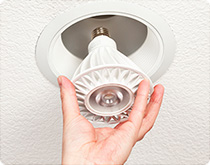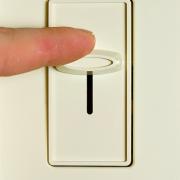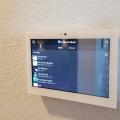Scope
Choose high-efficiency lighting for energy savings in new homes.
- Determine the lighting criteria for local applicable codes and any efficiency program targets.
- Design a lighting plan to meet or exceed these minimum targets.
- Consider including lighting controls such as motion sensors, timers, and dimmers for increased savings.
See the Compliance Tab for links to related codes and standards and voluntary federal energy-efficiency program requirements.
Description
Installing or switching from less efficient light bulbs such as traditional incandescent bulbs to high efficiency lighting such as light emitting diodes (LEDs) is one of the easiest steps to take to save on one’s energy bills. Standard incandescent bulbs produce light when an electric current passes through a filament and causes it to glow; they give off 90% of their energy as heat, not light. LEDs use a completely different process, giving off more light and less heat. LEDs use approximately 75% less energy than traditional incandescent bulbs to produce the same amount of light. They also last longer and produce less heat. Other ways to reduce lighting costs including adding lighting controls, such as dimmers, motion sensors, and photo sensors, and designing rooms to incorporate daylighting with traditional windows, clerestory windows, skylights, and solar tubes. Simply using lighter-colored walls, ceiling, floor, furniture, and appliances will have a significant impact on the amount of lighting needed in a home.
With passage of the Energy Independence and Security Act of 2007, new requirements were phased in requiring manufacturers to cut energy use for common light bulb types by about 27% by January 2014. (For example after the standard went into effect, "100-Watt" bulbs were required to use ≤ 72 W; 75 W were required to use ≤ 53 W; 60 W were required to use ≤ 43 W; and 40 W were required to use ≤ 29 W). By 2020, most standard light bulbs were required to be 60% to 70% more efficient than standard bulbs in 2007. Most LED lights were meeting that higher standard by 2011, cutting energy use 75% compared to standard incandescent bulbs, according to the EPA.
One concern about high-efficiency lighting choices has been color rendition, as some early lighting options, such as compact fluorescents, often appeared whiter or bluer than the familiar "warm" incandescents. Light color is measured on a temperature scale using Kelvin (K) units. Energy-efficient lighting products are available today in a variety of color renditions ranging from lower Kelvin (<3000K) "warm" yellowish lights to higher Kelvin (>5000K) cool white lights. For comparison, daylight is typically identified as 4500K or higher.
- For a warmer light, look for bulbs marked 2700-3000K.
- For a whiter light, look for bulbs marked 3500-4100K.
- For cooler white light, look for bulbs marked 5000-6500K.

Desired light output may also be hard to gauge for consumers used to thinking in terms of watts. Light output is measured in lumens. For comparison, a standard 100-Watt incandescent bulb puts out about 1600 lumens and a standard incandescent 60-W bulb puts out about 800 lumens. LED lights can output the same lumen levels, but at much lower wattage. Lumens and color temperature should be listed on the bulb packaging. Look for ENERGY STAR labeled lighting, which is required to meet criteria for light output, color, longevity, and efficiency. See these DOE websites for more on the history of lighting technology and basic principles of artificial lighting.
Solid State Light Emitting Diodes (LEDs)
LEDs, or light–emitting diodes, are a type of solid state lighting (SSL) that produce visible light very efficiently. LEDs are spurring a dramatic change in residential lighting due to their vast energy savings potential, low environmental impact, long lifetime, maintenance savings, size versatility, and compatibility with lighting controls. ENERGY STAR certified LED products use at least 75% less energy and last up to 25 times longer than traditional incandescent lighting. By 2027, widespread use of LEDs could save about 348 terawatt hours of electricity. This is equivalent to the annual electrical output of 44 large power plants (1000 megawatts each) and equals a savings of more than $30 billion at today's electricity prices.
LEDs produce light when voltage is applied to negatively charged semiconductors, causing electrons to flow from one material in the structure to another, which causes a series of complex interactions to create a unit of light (photon) in a very efficient, predictable, and orderly manner. This method of producing light is fundamentally different than that of any other light source. Key differences include the following:
- Light Source: The actual diode is the size of a fleck of pepper and comes in red, green, blue, or amber. These colors are typically combined to make white light.
- Direction: Unlike incandescent and fluorescent light bulbs, which emit light in all directions, LEDs emit light in a specific direction, which reduces the need for reflectors and diffusers and makes LEDs more efficient for uses such as recessed downlights and task lighting. With many other types of lighting such as incandescent and fluorescent lighting, the light is emitted in all directions and must be reflected toward the desired direction; with these types of lighting, more than half of the light may never leave the fixture.
- Heat: LEDs emit very little radiated heat. Heat is produced from the power going into the LED and this heat is absorbed and dissipated by a heat sink designed into the base of the LED.
- Durability: Because the actual light source in the LED is a tiny solid state chip rather than a fragile filament or glass tube, LEDs are more durable. Also LEDs don't “burn out.” Instead, LEDs experience lumen depreciation, meaning that over the life of the bulb, the amount of light produced decreases and the color appearance of the light can shift. Therefore, an LED product’s “lifetime” is determined by when its light output is predicted to decrease by 30%. Although many LED products today are designed to mirror the shape of traditional incandescent fixtures, the tiny size of the actual light source lends itself to great versatility in product size and shape.

When installing dimmable LED lighting, make sure to install a dimmer switch that is compatible with the light source. The High Efficacy Lighting New Construction Guide by Pacific Northwest National Laboratory provides insight on how to ensure success with energy-efficient lighting selections.
ENERGY STAR Certified Lighting
Lighting that earns the ENERGY STAR certification has met strict criteria ensuring energy efficiency, light output, color, and longevity. ENERGY STAR certified light bulbs:
- Use about 70%-90% less energy than traditional incandescent bulbs.
- Last at least 15 times longer and save about $80 in electricity costs over their lifetime.
- Meet strict quality and efficiency standards, are tested by accredited labs, and certified by a third party
- Produce about 70%-90% less heat, so they are safer to operate and can cut energy costs associated with home cooling.
The ENERGY STAR and DOE websites provide a wealth of information to consumers about selecting energy-efficient lighting:
- The DOE Energy Savers page Lighting Choices that Save You Money provides several tips and links for new and replacement lighting options.
- The ENERGY STAR Choose a Light Guide is an online tool that can help the homeowner identify the light bulb shape, color, and brightness appropriate to the household application. The Choose a Light Guide provides the homeowner with the right specifications to use in the purchase of new light bulbs.
- The homeowner can also use the ENERGY STAR LED Bulb Checklist as a resource in determining the light bulb replacement that’s appropriate for the application.
- For homeowners who want a detailed assessment of energy savings, the ENERGY STAR Savings Calculator for Certified Lighting provides custom energy savings based on bulb type, usage, incremental cost, and lifetime.
- Homeowners interested in understanding more about lighting can review the following ENERGY STAR web pages:
- Learn About Color and Mood
- Learn About Brightness
- Glossary of Terms
- When purchasing lighting at brick-and-mortar stores, homeowners should pay attention to the Lighting Facts Label, which is a mandatory product packaging label that provides the specifications detailing the lamp’s brightness, color, annual energy cost, lifetime, and power draw.
- Lighting controls such as timers and photocells save electricity by turning lights off when not in use. Dimmers save electricity when used to lower light levels. The homeowner should make sure to select lighting control products that are compatible with the energy-efficient bulbs.
- The homeowner can use the ENERGY STAR Product Finder to find ENERGY STAR certified light bulbs and fixtures that meet the household’s needs.
- The homeowner or contractor will want to check the Database of State Incentives for Renewables & Efficiency® or the ENERGY STAR Rebate Finder to determine whether a light bulb or fixture model is eligible for a rebate or incentive in the area.


Installing High-Efficacy Lighting
In new construction, specify high-efficiency lighting in a lighting plan that is part of the overall design package (Figure 6).

Figure 6. Design high-efficiency lighting into home plans. Select high-efficiency lighting that is rated for its installed location (e.g., interior or exterior) and that provides the desired light level, color rendering, and functionality (Figure 7). Select the right dimmer for the specific lighting being installed (Figure 8); some dimmers are specifically rated for CFLs or LEDs.

Figure 7. LEDs lamps are available for recessed lighting fixtures. 
Figure 8. Select dimmer switches that are compatible with installed lighting. - Inspect to verify that correct lighting products were installed.
Success
Hire a lighting designer knowledgeable in energy-efficient lighting, if necessary, to assist in developing a lighting plan. Choose the right lighting type for the application: install high-efficiency lighting that is rated for its installed location (i.e., inside, outside), and provides proper light level (lumens), color rendering, and functionality for its location and purpose. Select the right dimmer for the technology; some dimmers are specifically rated for CFLs or LEDs. Inspect to verify correct lighting products were installed.
Climate
Because high-efficiency LEDs produce less heat than traditional incandescent light sources, they may help to reduce cooling loads in warm and hot climates while seasonally reducing cooling loads in mixed or cool climates.
In cold climates, when specifying exterior lighting, consider light source options and applications. LEDs are a better choice for entrance lighting and motion-sensor activated security lighting than CFLs or fluorescent lamps, which are slow to come to full brightness at cold temperatures.
The map in Figure 1 shows the climate zones for states that have adopted energy codes equivalent to the International Energy Conservation Code (IECC) 2009, 12, 15, and 18. The map in Figure 2 shows the climate zones for states that have adopted energy codes equivalent to the IECC 2021. Climate zone-specific requirements specified in the IECC are shown in the Compliance Tab of this guide.


Training
Compliance
Retrofit
SCOPE
Replace current, inefficient lighting with high-efficiency lighting for energy savings and lower maintenance.
- Give priority to those fixtures that are used the most and those that are difficult to replace.
- Select ENERGY STAR certified light bulbs.
- Remove and recycle the old light bulbs.
- Install the new ENERGY STAR certified light bulbs.
- Please follow safe work practices as described in the U.S. Department of Energy’s Standard Work Specifications when upgrading lights in single-family homes, de-lamping areas in multifamily homes, and replacing lamps in multifamily homes.
DESCRIPTION
Replacing old, inefficient light bulbs with new high-efficiency light sources like LEDs is one of the easiest energy upgrades a homeowner can make and one of the most rewarding, with paybacks of well under a year on most products. According to the ENERGY STAR program, by replacing old, inefficient lights with ENERGY STAR labeled lighting products in only the five most frequently used light fixtures in the home, homeowners can typically save $75 per year. While replacing every standard incandescent bulb in the house would be ideal, if the budget doesn't permit that, focus on the most frequently used fixtures. Contractors performing lighting replacements as part of a home energy upgrade should also make hard-to-reach lights a priority, especially when the clients are elderly or handicapped.
For more information about LEDs and for links to information from ENERGY STAR, DOE, and others on high-efficiency lighting, see the Description tab in this guide.
How to Install Efficient Lighting in Existing Homes
1. Identify and prioritize inefficient bulbs that can be replaced.
2. Select high-efficiency lights as explained in the Description tab.
3. Remove and recycle the old light bulbs.
- Different types of light bulbs require different disposal or recycling methods. Consider researching light bulb recycling or disposal options prior to removing the bulbs.
- Incandescent light bulbs may or may not be eligible for recycling by your local municipality or recycling center. If they are not, it is ok to dispose of them with your garbage since the materials which make up these bulbs are non-toxic. As a safety precaution, use a cardboard box to contain the burned-out bulbs when recycling or disposing of them since the bulb glass is fragile.
- Halogen light bulbs should be handled like incandescent light bulbs. Unfortunately, halogen bulbs are less likely to be accepted by the local recycling program.
- CFLs contain very small amounts of mercury and should be recycled. The local recycling program likely accepts CFLs. Major hardware stores and home improvement retailers will often have drop-off locations for burned-out CFLs. Some models can be mailed to mail-in recycling centers. The U.S. EPA provides information on how and where to recycle CFLs, including information on mail-in services.
- LEDs should be recycled since certain models contain lead and arsenic. Contact the local recycling program to see if it will accept LED bulbs. Recyclers of consumer electronics typically also accept LED bulbs. Several organizations will recycle holiday lights at no charge through the mail.
- When removing burned-out light bulbs from sockets, shut off power to the light by switching off or unplugging the light. Wait a few minutes for the light to cool.
- Wear gloves when removing bulbs.
- If the bulb breaks, you will need to remove the broken light bulb base from the lamp holder.
- Shut off power to the light fixture at the breaker panel.
- Use needle-nose pliers to remove the bulb.
- If a CFL breaks, the U.S. EPA provides information on how to clean up a broken CFL.

4. Install new ENERGY STAR certified light bulbs.
- Remove the packaging from the new ENERGY STAR certified light bulbs. Ask the homeowner to keep the box and packaging materials for a few days in case the lamp has to be returned for replacement or repair.
- Ensure there is no power running to the light.
- Insert the replacement bulb into the socket. If it’s a screw-in light bulb, turn the bulb clockwise. Consider applying silicon lubricant or pencil lead to the bulb threads before installing to minimize sticking. Don't overtighten.
- Restore power to the light and switch it on to ensure it’s working properly.

4. Set up connected lighting.
- Setup will depend on the make and model of the connected light and control system. Read and follow the manufacturer’s instructions prior to setup. The following steps are generalized.
- Certain connected light models call for the use of a communications bridge. After screwing in the connected light bulbs, plug in the bridge and it should automatically power up. Connect the bridge to the Wi-Fi router using a network cable. The bridge should automatically establish a connection.
- Download the connected light manufacturer’s app to your mobile device. Once the app is loaded, follow the steps to connect it to the bridge. Now find the light on the app and begin controlling it.

COMPLIANCE
See Compliance tab.
More
More Info.
Access to some references may require purchase from the publisher. While we continually update our database, links may have changed since posting. Please contact our webmaster if you find broken links.
The following authors and organizations contributed to the content in this Guide.
Florida Solar Energy Center, lead for the Building America Partnership for Improved Residential Construction (BA-PIRC), a DOE Building America Research Team
Sales
High-Efficiency Lighting = Advanced Lighting Technology

High-efficiency lighting includes lamps and fixtures that have earned the ENERGY STAR label (or meet the ENERGY STAR requirements). Lighting products that have earned the ENERGY STAR certification deliver exceptional features while using about 70%-90% less energy and producing about 70%-90% less heat than traditional models using incandescent light bulbs. They also distribute light more efficiently and effectively, last 10 to 25 times longer, and come with a manufacturer-backed warranty of at least three years.



